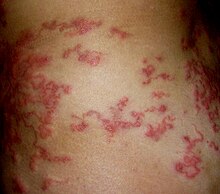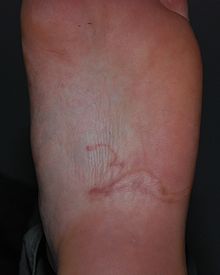Larva migrans cutanea
| Classification according to ICD-10 | |
|---|---|
| B76.9 | Hookworm disease, unspecified (Larva migrans cutanea onA) |
| ICD-10 online (WHO version 2019) | |
The larva migrans , Creeping eruption or skin mole is a skin disease caused by the larvae of various hookworms subspecies. It is one of the most common skin diseases in warm climates and the most common dermatosis acquired by travelers in the tropics. The disease was first described in 1874 and assigned to certain pathogens in 1928.
Pathogen
The pathogens are the larvae of Ancylostoma braziliense , Ancylostoma caninum , Ancylostoma tubaeforme , Uncinaria stenocephala and other species from the hookworm family (Ancylostomatidae). The pathogens do not develop into adult worms in humans because humans are false hosts . However, other roundworms and insects are also possible pathogens.
Occurrence
Ancylostoma species occur in warm countries (endemic to Africa, Central and South America, the Caribbean and Asia). In temperate regions (Mediterranean region) the pathogens can also occur at high temperatures.
transmission
The infection usually occurs when walking barefoot on floors and beaches contaminated with animal feces (dogs, cats).
Symptoms and course of the disease
The first symptoms show up after hours to a few weeks. There is a very itchy, serpentine-like reddening (serpiginous erythema ) and migratory paths that can be seen with the eye. One speaks here of a monocytic eosinophilic inflammatory reaction to the antigens of the larvae after their migration through the skin.
Frequent sites of infection (predilection sites) are the feet (often the soles of the feet), but infections in other areas of the body are also often found if, for example, B. was lying with his back on the sand.
The infection usually heals on its own in two to eight weeks if left untreated, but can occasionally last for up to two years.
diagnosis
The diagnosis is mainly made clinically and can be made through the typical skin lesions, the serpiginous exanthema. The larvae are only rarely detected. Under certain circumstances a progression of the larvae in the skin by a few millimeters per day can be observed.
Therapy and prophylaxis
The disease is self-limiting; it usually ends after one to three months when the larvae die.
In an S1 guideline , the German Dermatological Society (DDG) recommends oral therapy with ivermectin for adults and adolescents , or with albendazole if the therapy is unsuccessful or unavailable , in order to avoid itching, superinfections and psychological stress on the person concerned . Albendazole-containing ointments can also be used. To reduce the itching, creams containing glucocorticoids or systemic antihistamines can be used briefly . Only approved symptomatic therapies may be used during pregnancy and breastfeeding.
Surgical excision of the ducts or freezing are ineffective. There is no approval for the previous local therapy with thiabendazole .
Prophylaxis is to avoid walking barefoot on sandy surfaces that may be contaminated with dog or cat excrement, to keep dogs and cats away from beaches, sandpits and the like, and to regularly de-worm dogs and cats.
literature
- S1 guidelines for cutaneous larva migrans, diagnostics and therapy (creeping disease) of the German Society of Dermatology (DDG). In: AWMF online (as of 2013)
Individual evidence
- ↑ a b c P. E. Velho et al .: Larva migrans: a case report and review. In: Revista do Instituto de Medicina Tropical de São Paulo. Volume 45, Number 3, 2003 May-Jun, pp. 167-171, ISSN 0036-4665 . PMID 12870068 . (Review).
- ↑ a b K. Karthikeyan, DM Thappa: Cutaneous larva migrans. In: Indian Journal of Dermatology, Venereology and Leprology . Volume 68, Number 5, 2002 Sep-Oct, pp. 252-258, ISSN 0973-3922 . PMID 17656960 .
- ↑ a b Wieland Beck: Practice-relevant zoonotic pathogens: Larva migrans cutanea caused by hookworms (Ancylostoma spp. And Uncinaria stenocephala). In: Parasiten Spezial 1/2010 (publisher supplement to Veterinary Survey for Small Animal Medicine), pp. 14-17.
- ↑ a b S1 guidelines for cutaneous larva migrans, diagnostics and therapy (creeping disease) of the German Dermatological Society (DDG). In: AWMF online (as of 2013)

